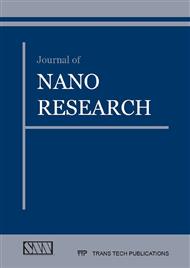p.1
p.13
p.20
p.28
p.36
p.42
p.51
p.58
p.68
Conductive Microwires of Silver Nanoparticles Prepared by Microcontact Printing
Abstract:
High resolution pattern of silver nanoparticles has received great attentions for its application in various electronic devices such as touch screen, OLED and solar cell. However, traditional printing techniques cannot meet the demands for high resolution. Here, we introduce a new method to prepare fine lines of nanoparticles less than 10 μm by microcontact printing (μCP), which was first used to surface modification and patterning. The PDMS stamp with 10 μm line width and space was prepared by replication of etched silicon template. Conductive silver ink was transferred from resource substrate to the target substrate using the PDMS stamp during μCP process. Transferred line patterns of silver nanoparticles were conductive and the resistance was about 100 Ω using two-point probe measure method after baking at 150°C for 30 min. We found that printing pressure imposed on the PDMS stamp was significant for the quality of lines during the μCP process and appropriate printing pressure was 7~9 KPa. The technology can be used as universal method to transfer other nanomaterials and create fine patterns with a simple and cost-effective manner.
Info:
Periodical:
Pages:
36-41
Citation:
Online since:
December 2015
Authors:
Price:
Сopyright:
© 2016 Trans Tech Publications Ltd. All Rights Reserved
Share:
Citation:


